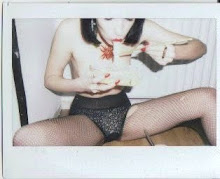NME

The first thing I noticed about NME is that the band name is larger than the magazine title: This insinuates two things: Firstly it insinuates that the main priority of this publication is to support bands instead of get their own fame and secondly that the magazine is already well known enough that the title doesn't need to be the main focus because people will recognise which magazine it is instantly.
The whole cover has a colour scheme of red, black and white which has rock connotations. These are the only colours on the cover which makes it look neater.
They have got the front-woman of the band to stand much further forward then her band mates which gives the reader and easier way of quickly identifying the band as opposed to forcing them to note all five faces. Glorifying the vocalist of a band in photos is a common recognition tactic.
Every feature displayed on the front cover includes a band name showing that they do not cover ANYTHING that isn't music related.
Rolling Stone 
Rolling Stone magazine are also a well recognised music magazine, so they have also let the cover star overshadow the brand name, this time by putting her head in front of it.
The colour scheme is pink and white, but pink is definitley the more predominant colour. The combination of all of the pink with the bubbles and the fact that the cover star is Lady Gaga screams Pop. Bubbles are often linked to Pop (because they pop) and so this is very relevant to the music of Gaga. I wouldn't want to use bubbles to signify the genre of my own magazine because, unless done extremely well (in this case shot by David LaChappelle) it can look really tacky.
Regarding the features of the cover there appears to be correlation between the size of the words and the importance of the story (the larger the writing the more important the story)
NME CONTENTS
The focal point of this contents page is 'The moment that Oasis kicked off their world tour'. Having a story in the contents makes it seem like the magazine is overflowing with news because theres multiple information in every single page (other than ad's obviously).
The colour ccheme of the contents is based around the colours of the logo (red/white)/black). However, they have added in flashes of yellow to draw the readers attention to other points of intrest, in this case the yellow is used to draw the reader to the subscription offer.
As well as having listings of news/radar/reviews/live/features there is also a band index which also shows how many different bands they cover in this one issue, again making it seem like they include more than they actually do. This is a way of making the reader feel as if theyre getting their money's worth.
The magazine name, band index, news etc and subscription section all frame the Oasis story which is another way of making people read it before they go off finding other things in the magazine. It is as if the editors have already decided the best way to make sure the reader takes in as much information as possible and almost pre-programmed their route through the magazine using focal points.

The main focal point of this double page spread is the featured band. This shows that although there is more than one story over these two pages, this is hte most important. The main headlines are written in a highlighted font, this also shows the reader which stories aremost important. Other, smaller features e.g. CRYSTAL CASTLES, is written in a different un-highlighted font insinuating less importance.
Having the 'EVERYONES TALKING ABOUT' section is another technique NME have used to make the reader feel that theyre getting more magazine for their money as there are four stories on one double page spread where most people would expect to find one article on one specific topic.
There is a definite colour scheme of blue/black/white on these pages. As the contents had a flash of yellow to highlight another importance, this double page spread has a small section involving the logo and background in red. This shows that even though the colour scheme has changed from the one used on the contents page there is still a running 4 colour theme through out this magazine which helps keep consistancy. The colour blue also has connotations of being 'cool' which ties in with the photographed band's laid-back poses and dress.
